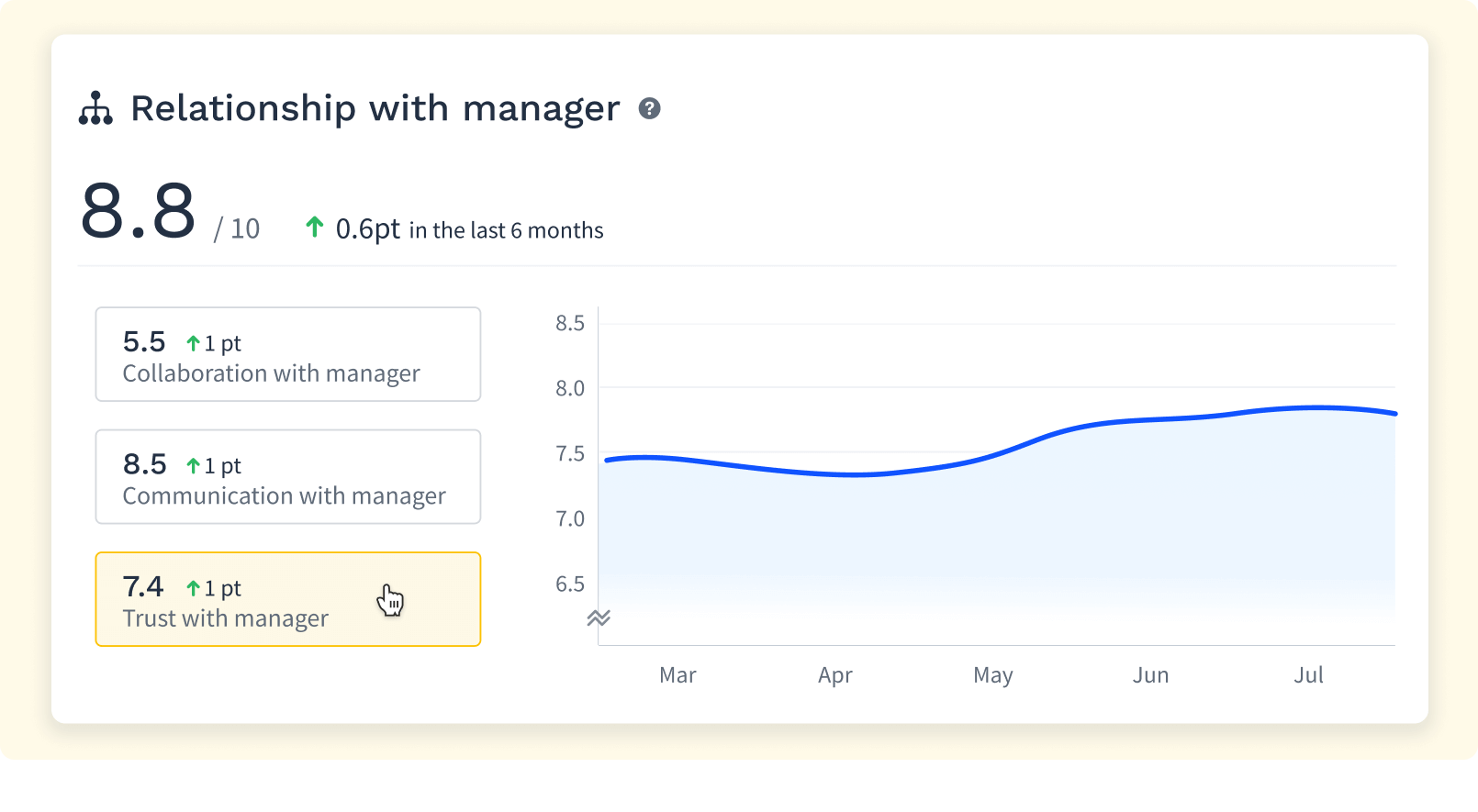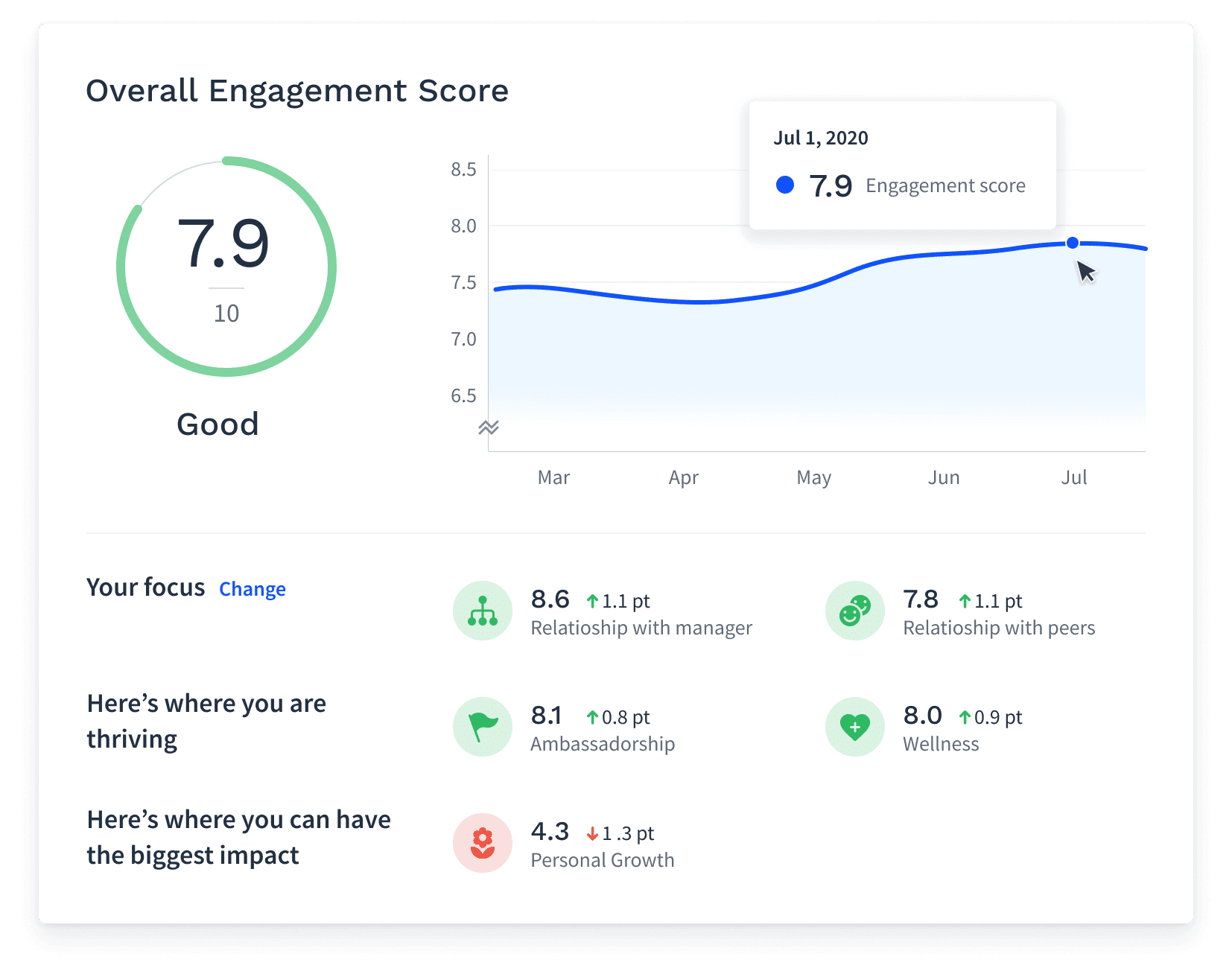We know that as a manager, you spend a lot of your energy building strong employee relationships with your team.
Strong relationships often result in better team member performance, less stress, and a better workplace experience. Overall, this type of "trust leadership" is the ideal way to build trust in the workplace.
But, you cannot have strong relationships if your team doesn’t see you as a trustworthy leader.
Without your team's trust in management, your role becomes difficult, and a sense of self-doubt can interfere with your ability to manage effectively.
According to Officevibe's Pulse Survey data, 86% of employees trust their direct manager.
86% of employees using Officevibe trust their direct manager
We want you to become part of that number by helping you to spot the signs that determine whether your team trusts you to manage them effectively or not, and show you how you can measure trust accurately.
Let's take a deeper look into why trust is important in leadership.
From flawed to flawless: 5 steps to leading distributed teams

What's in this article
Building trust as a leader: How to identify if your team members trust you
Are you a trustworthy leader? Are you actively building trust among your team members? These questions can only be determined in 2 steps:
- A self-reflection of your team’s behaviours towards you as their manager (i.e. self awareness)
- A metric evaluation of workplace trust
Self-awareness reflection: spot symptoms of mistrust on your team
The first step to determine if you have a trusting relationship between you and your employees is to self-reflect.
Symptoms that show high or low levels of workplace trust:
Let's run a quick diagnosis together. Take a few minutes to think about team dynamics. Reflect on the following scenarios and focus on your employees' behaviors:
1- How do they respond to organizational changes?
A) You’re not sure how they feel about the changes, but their actions show you that they strongly resist.
B) They communicate with you their concerns but are open to embracing change.
2) Do they ever say “no” to certain things or challenge your ideas?
A) You’re not sure how they feel about the changes, but their actions show you that they strongly resist.
B) They communicate with you their concerns but are open to embracing change.
3) Do they let you know about mistakes or when things go wrong?
A) You’re not sure how they feel about the changes, but their actions show you that they strongly resist.
B) They communicate with you their concerns but are open to embracing change.
4) Does your team bring in new ideas?
A) You’re not sure how they feel about the changes, but their actions show you that they strongly resist.
B) They communicate with you their concerns but are open to embracing change.
5) Do they give you honest feedback?
A) You’re not sure how they feel about the changes, but their actions show you that they strongly resist.
B) They communicate with you their concerns but are open to embracing change.
Results...
Behaviours A) reflect indicators and symptoms that show a lack of trust, while behaviors B) are indicators of trust. What are your results showing?
As we can see, building trust in the workplace is a complex interpersonal aspect of your leadership and role as a manager. Spotting the symptoms that show a lack of trust in the workplace is step one.
However, let's not stop here. A self-reflection exercise is a great place to start, but action is much more impactful when it comes from your team's feedback. If you really want to know if your team trusts you, you'll have to ask them directly.
Questions to evaluate levels of trust in management
Trust in the workplace is a metric that is measurable with the right set of tools.
At Officevibe, we believe it's essential for managers to measure workplace trust and employee trust on an ongoing basis. This lets you quickly uncover any gaps in your efforts in building a trusting relationship with everyone in your team and any areas where trust might have been broken.
It might even shed light on the source of some of your team's behaviors (such as low team performance or a decrease in employee engagement).
Here are some science-based survey questions to ask your team in order to determine your employees' trust levels. Note that some questions appear on a sliding scale.
Questions about trust in your team and organization
- How would you rate your direct manager's management skills?
- I feel like my direct manager is aware of his/her employees’ pain points (scale)
- My direct manager cares about my well-being (scale)
- My direct manager is someone I can trust (scale)
- My direct manager treats me with respect (scale)
Pro tip: Offering your team anonymity allows them to be able to answer truthfully. This is key if you want to accurately measure their level of trust in you. Tools like Officevibe's Pulse Survey software offer your team a safe space to share honest feelings and thoughts.

8 ways to build trust with your employees and in your workplace
1. Create open lines of communication
Open communication helps you know employees’ daily realities and shifting needs. It also helps you spot the places where they need support, visibility, or a new approach.
How managers can create open lines of communication:
- Ask for and receive feedback from your team often.
- Use an employee feedback solution like Officevibe.
- Take their feedback seriously and prioritize action.
- Show with them your plans and rationale
- Connect with them personally (1-on-1 meetings).
Did you know? 24% of employees using Officevibe report that their managers are not aware of their pain points. It is important to create strategies that allow you to keep up and help your team.
2. Practice transparency and visibility
Keeping your team in the dark about important information can result in a lack of trust, especially when it comes to big changes in your organization. The more pertinent information they have, the less anxious they will feel, and the more they will trust you.
How to be a transparent leader for your team:
- Communicate big changes in the organization.
- Share important information effectively and in a timely manner.
- Make information easily accessible to your teams.
3. Offer trust by default
Trust building goes both ways, and if you want your employees to trust you, you need to show that you trust them. When employees are empowered to leverage their strengths and expertise, it gives them the autonomy to do what they do best.
Tips to build trust by default to your employees:
- Do not micromanage! Check-in only at the planned touchpoints.
- Establish clear objectives then trust your team to perform.
- Remember that it's your job to share objectives and the direction your team needs to go in while leaving how they get there up to them.
4. Own mistakes and failures
Mistakes are inevitable and often offer a big learning opportunity. Taking responsibility shows that you are just as human as the rest of the team and that there is always room for improvement.
How to fully own your mistakes:
- Don't be afraid to say "hey team, I'm in the wrong" when it comes to performance or even behaviors. Calling yourself out breeds a culture of open discussion rather than fear.
- Come together with your team to unpack problems and learn through the process.
- Frame mistakes as a learning opportunity from the get-go and be an active participant in the exercise.
5. Allow yourself to be vulnerable
To be vulnerable is to be human. Allow yourself to be yourself, to say when you are confused, or when you don’t have all the answers. For managers, being vulnerable sets an example to their team and betters collaboration.
Tips for building trust by being vulnerable with your team:
- Be human and practive authentic leadership. If you're having a hard day, let them know.
- Be open about not having all the answers. No one is perfect.
- Ask for help when needed. Model this behavior so your employees know they can come to you for help too.
6. Over-communicate your trust
Sometimes all it takes is to remind people that you trust them. A simple act of direct communication can empower your team to feel equipped to do their job.
Effective communication as a vehicle for trust:
- During stressful times, remind your team of how much you all have accomplished.
- During post-mortems, remind people of what they did right.
- Use any opportunity to let your team members know how much you trust them.
7. Practice deep listening skills
A big part of trust is to feel like your team can talk to you. Practice deep listening so that you hear your team in a truthful and real way.
How to listen actively to your team:
- Listen without judgment or preconceived ideas.
- Summarize what people say to confirm you understood correctly.
- Ask follow-up questions to get more information.
8. Build a culture of feedback through employee engagement
A feedback culture allows employees to have a voice, feel in control of their environment, and ultimately be heard by their leaders. This ensures that they are active participants in the betterment of their own careers and in your development as a manager.
How to build a feedback culture:
- Ask for feedback about your role as a manager.
- Share the results with your team.
- Share with them your plan and take real action.
When you build strong foundations of trust in the workplace, your team will align around the central mission of their roles and put their best foot forward, so everyone can reach success—together.

Don’t forget, you can start measuring trust on your team today in order to take action where it really counts.
The positive impact of building trust with employees
If after self-reflecting and asking your team you realize that there is in fact a lack of trust, you need to take immediate action.
👉 According to our data, whether your team trusts you as their manager or not, will highly influence your working relationship with them.
Just think about a personal experience: Have you ever had a manager you couldn't trust? What about a manager you trusted fully? How much did this impact your work?
As a manager, it’s essential that you prioritize trust with your team from the outset, and then continue to nurture that trust most especially through times of change and growth. Learning to maintain trust is just as important as building trust.
The benefits of trust leadership and being a trusted leader
Here are a few examples of how building trust with your employees can help improve team morale and reach organizational goals.
- Establishing trust in the workplace helps with handling change.
- Trust has the potential to decrease stress by 74% and burnout.
- Teams that trust their managers have a 76% higher level of employee engagement.
- Trust in the workplace enables creativity and innovation.
- Trusting relationships are at the base of successful difficult conversations.
Given the above reasons, if trust is broken in your team, it's time to focus on improving it.
We developed strategies you can implement to take action and build trust with your team.
Equip HR and managers with tools to engage, recognize, and drive performance.




